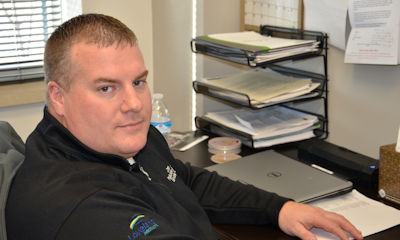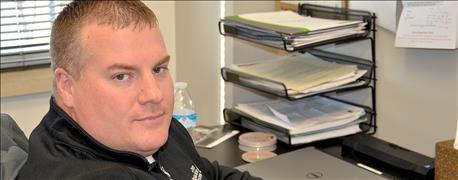
Kevin Adams doesn’t have a crystal ball. He bases what he sees ahead for agriculture on current relationships with farmer customers and experiences on his own farm.
Adams, Selma, is seed manager for Crop Production Services in northern and southeast Indiana. He works with CPS retailers, and also directly with 25 farmers. Just to keep himself grounded, he also farms with a family member.
Adams does more than just manage sales and distribution of six brands of seed. “I spend time in the field scouting, and help provide recommendations to farmers,” he says.

FACE THE FUTURE: Kevin Adams expects more changes in farming in the future. Lower commodity prices have slowed down some trends, but accelerated others, like selecting inputs with best potential for payback.
Adams is an Indiana Certified Crop Adviser. Nominated by the Delaware County Farm Bureau, he was selected as the Indiana CCA of the Year at the group’s recent convention.
Here are five trends Adams sees ahead for Indiana agriculture.
1. More GPS-based and precision-farming technology.
Auto-steer is popular, and Adams says it continues growing. He also believes other precision-based technologies, including those related to planting, will come quickly.
2. Variable-rate and multi-hybrid planting
Variable-rate seeding is here now. Adams works with several customers to prepare recommendations for different hybrids in various soils. While he believes that helps boost yield, he believes as multi-hybrid planting technology evolves, it will provide even more yield gains. “Putting the right hybrid on the right soil type just makes sense,” he says. “It will be especially valuable where soils are variable.”
3. Store more data for analysis
Several companies offer services that allow farmers to store crop data and make various comparisons. The CPS version is Echelon. It’s also heavily tied to soil sampling and tissue testing, and fine-tuning nutrient prescriptions.
“Lower corn prices slowed down these types of services, but I believe they’ll be important in the future,” Adams says.
4. Picking the right inputs
“Determining which inputs you need is also a challenge with cheaper corn prices,” he says. But there are more products all the time, including biological compounds. Not all work, but some do, he observes. “We’ll help farmers sort through the chaff and find products that really do provide a payback,” he says.
5. Crop scouting and more use of fungicides
One input that he believes is vital if and when conditions and hybrid choices demand it are fungicides. “We’ve seen good payback where they’re needed,” he says. “Most of our customers have them aerially applied. We shoot for applying fungicides where needed at the VT stage.” VT is tasseling in corn growth terms.
“Crop scouting and IPM will be even more important in the future,” Adams says. “The goal is protecting the ear leaf from disease. It isn’t a perfect science, but when lesions are there, you factor in hybrid genetics and what you expect the weather to do, and make a decision,” he observes.
About the Author(s)
You May Also Like




